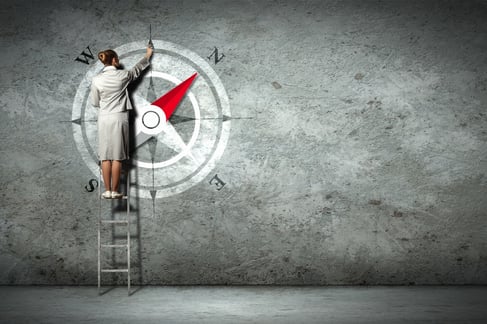 Hoshin Kanri is a Lean management technique for getting strategy, tactics, and improvement efforts in sync across the entire organization. It is translated as “strategy deployment” or “management compass.” The goal is to ensure that every individual from the front-line team to the C-suite understands the organization’s most important goals and works to achieve them through continuous improvement work on small projects and major priorities alike. The Hoshin Kanri methodology helps everyone keep their eye on the long-term strategic objectives, while still reaching short-term goals and tactically managing the day-to-day needs of the organization.
Hoshin Kanri is a Lean management technique for getting strategy, tactics, and improvement efforts in sync across the entire organization. It is translated as “strategy deployment” or “management compass.” The goal is to ensure that every individual from the front-line team to the C-suite understands the organization’s most important goals and works to achieve them through continuous improvement work on small projects and major priorities alike. The Hoshin Kanri methodology helps everyone keep their eye on the long-term strategic objectives, while still reaching short-term goals and tactically managing the day-to-day needs of the organization.
Communication and organization are the keys to the success of Hoshin Kanri because managing long-term strategy, short-term goals, and daily improvement activities can be a huge challenge, especially if you have many people involved in the effort. For years, organizations have relied on tools such as complicated spreadsheets, email threads, file sharing systems, and even paper boards to track and manage the strategy, but these passive systems often fail to provide the support necessary to make lasting progress. They are time-consuming, rarely kept up-to-date, and ineffective at driving activity.
Listen to this Post and Subscribe to the Podcast:
Organizations that have been successful in their Hoshin Kanri efforts have realized that purpose built improvement software can make all the difference.
Visibility is Essential for Alignment
What sets Hoshin Kanri apart from other strategic planning approaches is that it embraces organization-wide strategy deployment. It is not a trickle-down plan that is deposited upon the organization from on high. The idea is to open up the doors and get everyone involved in planning, increasing the odds of alignment and ensuring that the strategy is informed by the valuable insight that employees at every level have to offer.
Improvement software gives everyone a vision into the strategy by addressing the needs of both employees and leaders.
Employees
Alignment can only be achieved when every single person understands the organization’s overall goals and how their personal goals are related to the strategic plan. They also need to understand how progress toward those goals is being tracked and measured.
Improvement software gives employees a way to understand and share the impact of the improvement work they do, whether it is an incremental improvement or a major project. The system provides a method of tracking responsibilities, collaborating with peers, and reporting progress. All of this leads to faster improvement and increased engagement.
Leaders
It is the leader’s role to control the direction of the strategy deployment efforts and make sure that momentum is maintained. That requires time and attention, so anything that eases the administrative burden can help free up leaders to coach and develop employees.
Improvement software creates transparency so that leaders can easily see which employees and teams are actively engaged in improvement. Leaders can tell where improvement culture is thriving and where it is struggling to take hold. That provides the basis for smart action and increases accountability.
Structured Information Accelerates the Pace of Improvement
The strategic direction is often supported with a variety of improvement techniques including Kaizen events, A3s, value stream mapping, daily improvement, workouts, and other Lean projects. Ideally, there should be a direct connection between each of these activities and the Hoshin Kanri goals and objectives.
Improvement software gives you one home for all of the project detail and documents associated with these techniques. There is one version of the truth, making defined alignment possible.
Top-Down and Bottom-Up Improvement
While Hoshin Kanri is a collaborative approach that avoids dictates from the C-suite, the strategic goals do start at the top level and cascade down through the organization, with a clear map defining the relationships between them. Improvement software helps this happen by creating a hierarchy of projects that are aligned to top-level goals. Everyone can see how each improvement event or project fits into the larger strategic picture. The best solutions also help create better focus, avoiding the common tendency to label everything as “the highest priority.” (If everything is critical, nothing is critical.) Good improvement software gives leaders a way to prioritize improvements and goals and communicate those priorities to the entire organization.
Bottom-up improvements also play a critical role in continuous improvement. The right technology solution will allow users to relate improvements with the strategic objective that they support. Due credit can be assigned to employee ideas that further the overall mission.
Additional features that speed the path to improvement include:
- Notifications and alerts
- Visual improvement management
- Detailed impact reports
- Search capabilities
- Document management
- Improvement broadcasting
Hoshin planning can have a major impact on whether an organization achieves the strategic breakthroughs they seek. The right software support leads to a faster improvement cycle, more engaged employees, greater alignment and the best chance of success.

![[Watch Now] Cascading Strategy Through Hoshin Kanri](https://no-cache.hubspot.com/cta/default/326641/dd5ad176-fb74-4e1e-bf28-ff4d966d1701.png)


Add a Comment